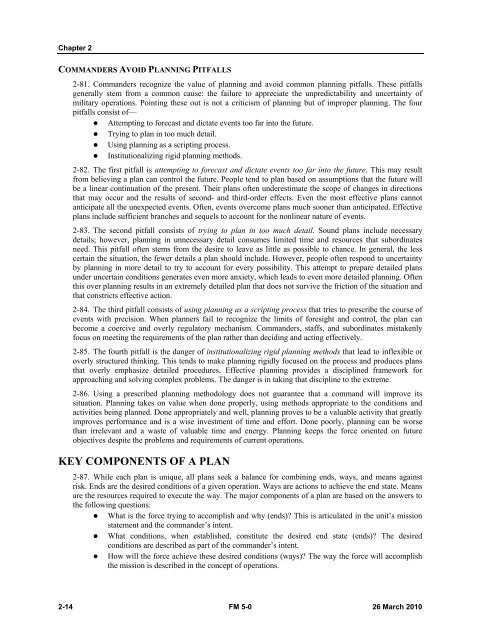FM 5-0, The Operations Process - Federation of American Scientists
FM 5-0, The Operations Process - Federation of American Scientists
FM 5-0, The Operations Process - Federation of American Scientists
Create successful ePaper yourself
Turn your PDF publications into a flip-book with our unique Google optimized e-Paper software.
Chapter 2<br />
COMMANDERS AVOID PLANNING PITFALLS<br />
2-81. Commanders recognize the value <strong>of</strong> planning and avoid common planning pitfalls. <strong>The</strong>se pitfalls<br />
generally stem from a common cause: the failure to appreciate the unpredictability and uncertainty <strong>of</strong><br />
military operations. Pointing these out is not a criticism <strong>of</strong> planning but <strong>of</strong> improper planning. <strong>The</strong> four<br />
pitfalls consist <strong>of</strong>—<br />
• Attempting to forecast and dictate events too far into the future.<br />
• Trying to plan in too much detail.<br />
• Using planning as a scripting process.<br />
• Institutionalizing rigid planning methods.<br />
2-82. <strong>The</strong> first pitfall is attempting to forecast and dictate events too far into the future. This may result<br />
from believing a plan can control the future. People tend to plan based on assumptions that the future will<br />
be a linear continuation <strong>of</strong> the present. <strong>The</strong>ir plans <strong>of</strong>ten underestimate the scope <strong>of</strong> changes in directions<br />
that may occur and the results <strong>of</strong> second- and third-order effects. Even the most effective plans cannot<br />
anticipate all the unexpected events. Often, events overcome plans much sooner than anticipated. Effective<br />
plans include sufficient branches and sequels to account for the nonlinear nature <strong>of</strong> events.<br />
2-83. <strong>The</strong> second pitfall consists <strong>of</strong> trying to plan in too much detail. Sound plans include necessary<br />
details; however, planning in unnecessary detail consumes limited time and resources that subordinates<br />
need. This pitfall <strong>of</strong>ten stems from the desire to leave as little as possible to chance. In general, the less<br />
certain the situation, the fewer details a plan should include. However, people <strong>of</strong>ten respond to uncertainty<br />
by planning in more detail to try to account for every possibility. This attempt to prepare detailed plans<br />
under uncertain conditions generates even more anxiety, which leads to even more detailed planning. Often<br />
this over planning results in an extremely detailed plan that does not survive the friction <strong>of</strong> the situation and<br />
that constricts effective action.<br />
2-84. <strong>The</strong> third pitfall consists <strong>of</strong> using planning as a scripting process that tries to prescribe the course <strong>of</strong><br />
events with precision. When planners fail to recognize the limits <strong>of</strong> foresight and control, the plan can<br />
become a coercive and overly regulatory mechanism. Commanders, staffs, and subordinates mistakenly<br />
focus on meeting the requirements <strong>of</strong> the plan rather than deciding and acting effectively.<br />
2-85. <strong>The</strong> fourth pitfall is the danger <strong>of</strong> institutionalizing rigid planning methods that lead to inflexible or<br />
overly structured thinking. This tends to make planning rigidly focused on the process and produces plans<br />
that overly emphasize detailed procedures. Effective planning provides a disciplined framework for<br />
approaching and solving complex problems. <strong>The</strong> danger is in taking that discipline to the extreme.<br />
2-86. Using a prescribed planning methodology does not guarantee that a command will improve its<br />
situation. Planning takes on value when done properly, using methods appropriate to the conditions and<br />
activities being planned. Done appropriately and well, planning proves to be a valuable activity that greatly<br />
improves performance and is a wise investment <strong>of</strong> time and effort. Done poorly, planning can be worse<br />
than irrelevant and a waste <strong>of</strong> valuable time and energy. Planning keeps the force oriented on future<br />
objectives despite the problems and requirements <strong>of</strong> current operations.<br />
KEY COMPONENTS OF A PLAN<br />
2-87. While each plan is unique, all plans seek a balance for combining ends, ways, and means against<br />
risk. Ends are the desired conditions <strong>of</strong> a given operation. Ways are actions to achieve the end state. Means<br />
are the resources required to execute the way. <strong>The</strong> major components <strong>of</strong> a plan are based on the answers to<br />
the following questions:<br />
• What is the force trying to accomplish and why (ends)? This is articulated in the unit’s mission<br />
statement and the commander’s intent.<br />
• What conditions, when established, constitute the desired end state (ends)? <strong>The</strong> desired<br />
conditions are described as part <strong>of</strong> the commander’s intent.<br />
• How will the force achieve these desired conditions (ways)? <strong>The</strong> way the force will accomplish<br />
the mission is described in the concept <strong>of</strong> operations.<br />
2-14 <strong>FM</strong> 5-0 26 March 2010















